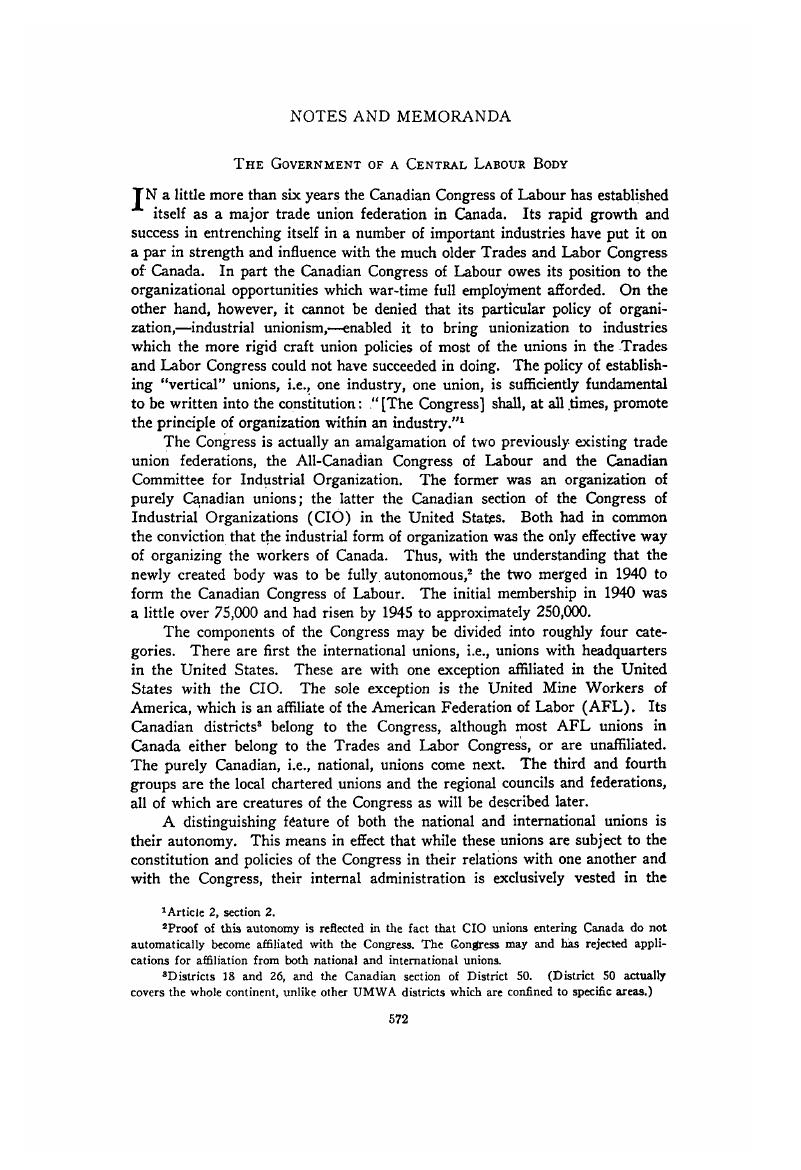No CrossRef data available.
Published online by Cambridge University Press: 07 November 2014

1 Article 2, section 2.
2 Proof of this autonomy is reflected in the fact that CIO unions entering Canada do not automatically become affiliated with the Congress. The Congress may and has rejected applications for affiliation from both national and international unions.
3 Districts 18 and 26, and the Canadian section of District 50. (District 50 actually covers the whole continent, unlike other UMWA districts which are confined to specific areas.)
4 At an Executive Council meeting of the Congress, held in February, 1946, it was decided that “any affiliated union which fails to implement any decision of the Jurisdiction Committee of the Congress, requiring it to discontinue admitting to membership or retaining in membership of any of its locals workers who the Committee decides are within the jurisdiction of another affiliated union, shall be denied representation at any Convention, Council or Committee of the Congress, unless or until the decision of the Jurisdiction Committee has been rescinded at a properly constituted meeting of the Executive Council or Convention of the Congress” (Canadian Unionist, Mar. 1946).
5 Article 3, section 8.
6 An organizing committee is inferior to a full-fledged union inasmuch as it is a federation of locals of a similar character, the whole being under the direct control of the director of organization, hence of the Executive Council of the Congress. It is nonetheless treated as an affiliate under the constitution (Article 3, section 6).
7 Article 2, section 2; Article 3, sections 2 and 7; Article 14, section 1.
8 E.g., Textile Workers' Organizing Committee; Shoe and Leather Workers' Organizing Committee; Office and Professional Workers' Organizing Committee.
9 Fédération des Ouvriers des Chantiers de 1'Est du Canada (Eastern Shipyard Workers' Federation of Canada); Shipyard General Workers' Federation of British Columbia; Maritime Workers' Federation. Such federations have tended to assume the characteristics of fully autonomous unions with the consequent subordination of their constituent locals.
10 E.g., the Shoe and Leather Workers' Organizing Committee was converted into the National Union of Shoe and Leather Workers.
11 E.g., La Fraternité Canadienne des Employés d'Incendie (Canadian Brotherhood of Fire Fighters); National Union of Furniture Workers and Allied Crafts.
12 The Textile Workers' Organizing Committee was merged with the Textile Workers Union of America on the latter's admission into the Congress. Individual locals have been handed over to the Retail, Wholesale and Department Store Union; the Canadian Brotherhood of Railway Employees and Other Transport Workers; the United Automobile, Aircraft and Agricultural Implement Workers of America, etc.
13 Article 2, sections 1 and 2.
14 Article 6, section 2.
15 Article 14, section 2.
16 The whole of Article 14.
17 In Ottawa, for example, the employees of four dairies organized by the Congress exist under four separate charters, while the workers of several lumber yards are all organized into one local.
18 Article 3, section 10.
19 Article 3, section 4.
20 E.g., Cape Breton Labour Council, Gananoque and District Labour Council, Lakeside District Labour Council, Twin Cities Labour Council, Okanagan Valley Labour Council.
21 All of Article 15.
22 The Ottawa Labour Council has set an affiliation fee of 2 cents per month, per member.
23 The whole of Article 4 is related to the convention and related matters.
24 No convention was held during 1945 owing to war-time restrictions.
25 Article 17.
26 Article 4, section 17. Actually, however, the convention is opened and some formalities observed pending the report of the Credential Committee. At the 1944 convention in Quebec City, for instance, the convention was opened on October 16 at 10.15 A.M., but the Committee did not make its report until after the convention reconvened after lunch at 2.30 P.M. The morning was spent in listening to various guest speakers.
27 Article 4, sections 12, 13, 14, and 16.
28 Contained in Article 18. Beyond these rules Bourinot's Rules of Order are applicable.
29 Article 3, sections 9 and 11.
30 Article 5, section 4; Article 6, section 3.
31 Proceedings of the Fifth Annual Convention, 1944, pp. 53-5.
32 Article 6, section 1.
33 There are at present a research department, a publicity director, a political action committee, a jurisdiction committee, a wage advisory committee, regional directors of organization, a staff of organizers and office personnel in various cities.
34 Article 6.
35 Article 3, section 9.
36 Article 7.
37 Article 8. This residuary power of the president has been rarely used; in fact, only once.
38 Article 10.
39 Article 11.
40 Article 13. At present there are two official publications: The Canadian Unionist, published from Congress headquarters in Ottawa, and Les Nouvelles Ouvrières, published from the regional office in Montreal. Both are monthly publications.